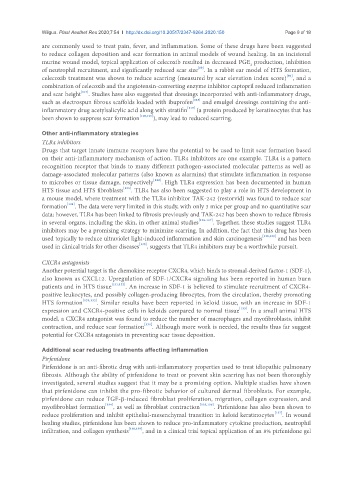Page 630 - Read Online
P. 630
Wilgus. Plast Aesthet Res 2020;7:54 I http://dx.doi.org/10.20517/2347-9264.2020.150 Page 9 of 18
are commonly used to treat pain, fever, and inflammation. Some of these drugs have been suggested
to reduce collagen deposition and scar formation in animal models of wound healing. In an incisional
murine wound model, topical application of celecoxib resulted in decreased PGE production, inhibition
2
[89]
of neutrophil recruitment, and significantly reduced scar size . In a rabbit ear model of HTS formation,
[90]
celecoxib treatment was shown to reduce scarring (measured by scar elevation index score) , and a
combination of celecoxib and the angiotensin-converting enzyme inhibitor captopril reduced inflammation
and scar height [117] . Studies have also suggested that dressings incorporated with anti-inflammatory drugs,
such as electrospun fibrous scaffolds loaded with ibuprofen [118] and emulgel dressings containing the anti-
inflammatory drug acetylsalicylic acid along with stratifin [119] (a protein produced by keratinocytes that has
been shown to suppress scar formation [120,121] ), may lead to reduced scarring.
Other anti-inflammatory strategies
TLR4 inhibitors
Drugs that target innate immune receptors have the potential to be used to limit scar formation based
on their anti-inflammatory mechanism of action. TLR4 inhibitors are one example. TLR4 is a pattern
recognition receptor that binds to many different pathogen-associated molecular patterns as well as
damage-associated molecular patterns (also known as alarmins) that stimulate inflammation in response
to microbes or tissue damage, respectively [122] . High TLR4 expression has been documented in human
HTS tissue and HTS fibroblasts [123] . TLR4 has also been suggested to play a role in HTS development in
a mouse model, where treatment with the TLR4 inhibitor TAK-242 (restorvid) was found to reduce scar
formation [124] . The data were very limited in this study, with only 3 mice per group and no quantitative scar
data; however, TLR4 has been linked to fibrosis previously and TAK-242 has been shown to reduce fibrosis
in several organs, including the skin, in other animal studies [125-127] . Together, these studies suggest TLR4
inhibitors may be a promising strategy to minimize scarring. In addition, the fact that this drug has been
used topically to reduce ultraviolet light-induced inflammation and skin carcinogenesis [128,129] and has been
used in clinical trials for other diseases [130] , suggests that TLR4 inhibitors may be a worthwhile pursuit.
CXCR4 antagonists
Another potential target is the chemokine receptor CXCR4, which binds to stromal-derived factor-1 (SDF-1),
also known as CXCL12. Upregulation of SDF-1/CXCR4 signaling has been reported in human burn
patients and in HTS tissue [131,132] . An increase in SDF-1 is believed to stimulate recruitment of CXCR4-
positive leukocytes, and possibly collagen-producing fibrocytes, from the circulation, thereby promoting
HTS formation [131,132] . Similar results have been reported in keloid tissue, with an increase in SDF-1
expression and CXCR4-positive cells in keloids compared to normal tissue [133] . In a small animal HTS
model, a CXCR4 antagonist was found to reduce the number of macrophages and myofibroblasts, inhibit
contraction, and reduce scar formation [131] . Although more work is needed, the results thus far suggest
potential for CXCR4 antagonists in preventing scar tissue deposition.
Additional scar reducing treatments affecting inflammation
Pirfenidone
Pirfenidone is an anti-fibrotic drug with anti-inflammatory properties used to treat idiopathic pulmonary
fibrosis. Although the ability of pirfenidone to treat or prevent skin scarring has not been thoroughly
investigated, several studies suggest that it may be a promising option. Multiple studies have shown
that pirfenidone can inhibit the pro-fibrotic behavior of cultured dermal fibroblasts. For example,
pirfenidone can reduce TGF-β-induced fibroblast proliferation, migration, collagen expression, and
myofibroblast formation [134] , as well as fibroblast contraction [135,136] . Pirfenidone has also been shown to
reduce proliferation and inhibit epithelial-mesenchymal transition in keloid keratinocytes [137] . In wound
healing studies, pirfenidone has been shown to reduce pro-inflammatory cytokine production, neutrophil
infiltration, and collagen synthesis [138,139] , and in a clinical trial topical application of an 8% pirfenidone gel

